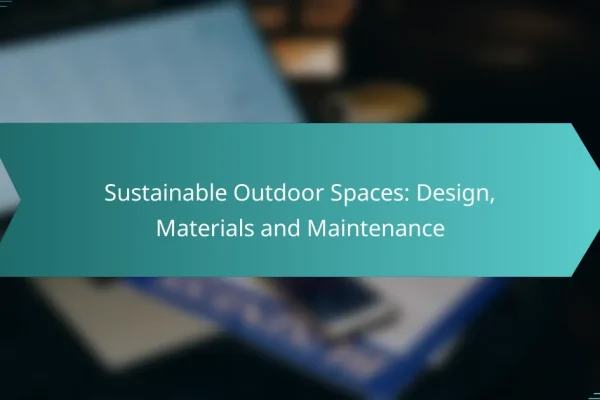What are the best sustainable home renovation practices in the UK?
The best sustainable home renovation practices in the UK focus on energy efficiency, resource conservation, and environmentally friendly materials. Implementing these practices can significantly reduce your carbon footprint and lower utility costs.
Energy-efficient insulation
Energy-efficient insulation is crucial for maintaining a comfortable indoor temperature while minimizing energy consumption. Consider options like mineral wool, cellulose, or spray foam, which can reduce heat loss by up to 30% when properly installed.
When renovating, ensure that your insulation meets UK standards, such as the Building Regulations, which require adequate thermal performance. Pay attention to areas like roofs, walls, and floors, as these are common sources of heat loss.
Solar panel installation
Installing solar panels can significantly decrease your reliance on grid electricity and lower energy bills. In the UK, solar photovoltaic (PV) systems can generate energy to power your home and even allow you to sell excess energy back to the grid through the Feed-in Tariff scheme.
When considering solar panels, evaluate your roof’s orientation and shading, as these factors affect energy production. A typical system can cost between £4,000 and £8,000, but government incentives may help offset initial expenses.
Recycled materials usage
Using recycled materials in your renovation can reduce waste and lower environmental impact. Options include reclaimed wood for flooring or furniture, recycled glass for countertops, and repurposed bricks for walls.
Look for local suppliers who specialize in reclaimed materials, as this can also support the community. Incorporating recycled materials not only benefits the environment but can also add unique character to your home.
Water-saving fixtures
Water-saving fixtures, such as low-flow toilets, showerheads, and faucets, can significantly reduce water consumption in your home. These fixtures can cut water usage by up to 50%, which is beneficial for both the environment and your water bill.
When selecting fixtures, look for products with the WaterSense label, which indicates they meet efficiency criteria set by the UK government. Installing these fixtures is often straightforward and can lead to substantial long-term savings.
Eco-friendly paint options
Eco-friendly paint options are available that minimize harmful chemicals and reduce indoor air pollution. Look for paints labeled as low-VOC (volatile organic compounds) or zero-VOC, which are safer for both your health and the environment.
When choosing paint, consider natural pigments and biodegradable options. These paints may have a slightly higher upfront cost but can contribute to a healthier living space and are often more durable, reducing the need for frequent repainting.
How can I choose sustainable materials for my renovation?
Choosing sustainable materials for your renovation involves selecting products that minimize environmental impact while ensuring durability and safety. Focus on materials that are locally sourced, certified for sustainability, and designed for longevity to achieve the best results.
Local sourcing advantages
Local sourcing reduces transportation emissions and supports the local economy. By purchasing materials from nearby suppliers, you can often find options that are fresher and better suited to your regional climate.
Additionally, local materials can enhance the character of your home, reflecting the architectural style and natural resources of your area. This can lead to a more cohesive and aesthetically pleasing renovation.
Certifications to look for
When selecting sustainable materials, look for certifications that indicate environmental responsibility. Common certifications include Forest Stewardship Council (FSC) for wood products, Energy Star for appliances, and LEED for overall building practices.
These certifications provide assurance that the materials meet specific sustainability standards, helping you make informed choices. Always verify the credibility of the certification to ensure it aligns with your sustainability goals.
Durability and lifecycle assessment
Durability is a key factor in sustainable renovations, as longer-lasting materials reduce the need for frequent replacements. Assess the lifecycle of materials by considering their production, use, and disposal impacts.
Choose materials that are designed to withstand wear and tear, such as recycled metal roofing or composite decking. Evaluating the lifecycle can help you understand the total environmental footprint, guiding you toward choices that are both sustainable and cost-effective over time.
What are the cost implications of sustainable renovations?
Sustainable renovations often involve higher initial costs but can lead to significant long-term savings. Homeowners should consider both the upfront investment and the potential reductions in utility bills and maintenance expenses over time.
Initial investment vs. long-term savings
The initial investment for sustainable renovations, such as energy-efficient windows or solar panels, can be substantial, often ranging from a few thousand to tens of thousands of dollars. However, these upgrades typically result in lower energy costs, with savings that can accumulate to hundreds or even thousands of dollars annually.
Homeowners should evaluate the payback period for these investments, which can vary widely based on local energy prices and the specific upgrades made. Generally, a payback period of 5-10 years is common for many sustainable renovations.
Government grants and incentives
Many governments offer grants, tax credits, and other incentives to encourage sustainable renovations. These financial aids can significantly reduce the initial costs, making it more feasible for homeowners to invest in eco-friendly upgrades.
For example, in the United States, programs like the Federal Investment Tax Credit can cover a percentage of the cost for solar installations. Homeowners should research local and federal incentives to maximize their savings.
Cost comparison with traditional methods
When comparing sustainable renovations to traditional methods, it’s essential to consider both upfront costs and long-term benefits. While traditional materials and systems may have lower initial prices, they often lead to higher energy bills and increased maintenance costs over time.
For instance, traditional heating systems may cost less to install but can lead to significantly higher energy expenses compared to energy-efficient alternatives. Homeowners should conduct a thorough cost-benefit analysis to determine the best approach for their renovation projects.
What are the common challenges in sustainable renovations?
Sustainable renovations often face challenges such as finding qualified contractors, balancing aesthetics with eco-friendly choices, and navigating regulatory hurdles. Addressing these issues is crucial for successful and responsible home improvements.
Finding qualified contractors
One of the primary challenges in sustainable renovations is locating contractors who specialize in eco-friendly practices. Many traditional contractors may lack the knowledge or experience necessary to implement sustainable materials and techniques effectively.
To find qualified professionals, consider seeking referrals from local green building organizations or using online platforms that focus on sustainable construction. Always check for certifications in green building practices, such as LEED or BREEAM, to ensure expertise.
Balancing aesthetics and sustainability
Homeowners often struggle to merge their design preferences with sustainable practices. While eco-friendly materials can sometimes differ in appearance from conventional options, many sustainable products now offer a variety of styles that can meet aesthetic desires.
To achieve a balance, explore options like reclaimed wood, low-VOC paints, and energy-efficient fixtures that enhance both beauty and sustainability. Prioritize designs that incorporate natural light and ventilation, which can reduce energy consumption while maintaining visual appeal.
Regulatory hurdles in the UK
In the UK, navigating regulatory requirements can pose significant challenges during sustainable renovations. Homeowners must comply with local building codes, planning permissions, and environmental regulations, which can vary by region.
To mitigate these challenges, familiarize yourself with the relevant regulations before starting your project. Consult with local authorities or a knowledgeable contractor to ensure compliance with standards such as the Building Regulations and any specific environmental assessments that may be required.
How can I ensure my renovation is energy-efficient?
To ensure your renovation is energy-efficient, focus on incorporating sustainable materials, optimizing insulation, and utilizing energy-efficient appliances. These steps can significantly reduce energy consumption and lower utility bills over time.
Energy audits and assessments
Conducting an energy audit is a crucial first step in identifying areas for improvement in your home. This assessment evaluates your current energy use and pinpoints inefficiencies, such as air leaks or outdated appliances. Many local utility companies offer free or subsidized energy audits to homeowners.
After the audit, you will receive a report detailing recommended upgrades, which may include enhancing insulation, sealing ducts, or replacing windows. Prioritize these recommendations based on potential energy savings and your budget.
Smart home technology integration
Integrating smart home technology can enhance energy efficiency by allowing you to monitor and control energy use more effectively. Smart thermostats, for instance, can adjust heating and cooling based on your schedule, potentially reducing energy costs by up to 10-15%.
Consider adding smart lighting systems that automatically turn off when rooms are unoccupied or smart plugs that allow you to control devices remotely. These technologies not only improve convenience but also contribute to a more sustainable home environment.












